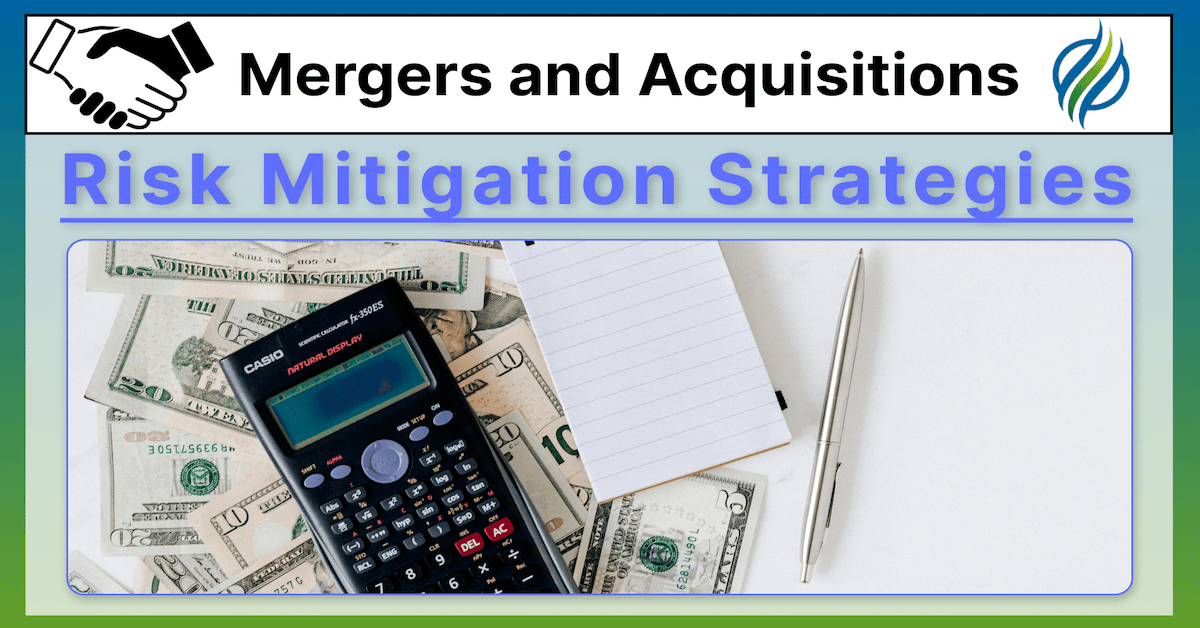Imagine the following…
A promising business acquisition falls apart at the eleventh hour, not due to lack of interest or funding, but because a critical risk was overlooked.
This scenario is more common than you might think.
 Key Takeaways
Key Takeaways
- Conduct Thorough Due Diligence: Verify all financial, legal, and operational details to avoid costly surprises in business transactions.
- Use Escrow Accounts: Secure transactions and mitigate financial risks by utilizing escrow services to hold funds during deals.
- Negotiate Strong Warranties and Indemnities: Protect your investment by ensuring robust legal safeguards are in place to cover potential future liabilities.
- Foster a Risk-Aware Culture: Educate and empower your team on risk management to enhance decision-making and business resilience.
- Consult Experts: Leverage specialized legal and financial advice to tailor risk mitigation strategies to your business's unique needs.
According to a survey conducted by the Risk Management Association (RMA) in collaboration with Oliver Wyman, found that 90% of CROs plan to upgrade at least one core treasury risk management capability.
This highlights the critical focus on enhancing risk management practices in response to recent challenges in the financial sector.
Understanding the intricacies of risk mitigation is not just about protecting assets; it’s about ensuring the stability and growth of your business.
Whether you’re buying a new company or selling a part of your business, the stakes are incredibly high.
The right strategies can shield your profits and pave the way for future success.
 Table of Contents
Table of Contents
This article aims to arm you with practical, effective strategies to minimize the challenges and risks associated with business transactions.
We’ll explore how thorough due diligence, financial safeguards like escrow accounts, and legal mechanisms such as warranties and indemnities can serve as your armor in the complex world of business deals.
More importantly, we’ll focus on the benefits of each strategy, helping you understand not just how they work, but how they can work for you, enhancing your business’s potential for success and stability.
Stay tuned as we delve into these strategies, each designed to secure your investment and fortify your future endeavors.
Understanding the Landscape of Business Risks

Navigating the world of business transactions means being familiar with the terrain of risks that accompany them.
These risks, if not managed properly, can undermine even the most promising deals.
Let’s break down the most commom types of risks businesses encounter.
Identifying Common Risks:
1. Financial Risks:
These include unexpected costs, poor financial performance of the target company, and issues with cash flow or debt levels.
2. Legal Risks:
Involving breaches of contracts, non-compliance with regulations, or intellectual property issues.
3. Operational Risks:
Such as integration problems, technology failures, or cultural mismatches in mergers and acquisitions.
Each of these risks requires careful consideration and strategic planning to mitigate effectively.
For example, financial due diligence can uncover hidden liabilities, while thorough legal reviews can prevent future litigation.
Importance of Risk Assessment:
Risk assessment acts as your first line of defense.
By identifying potential threats early, you can:
-
Devise mitigation strategies: Tailored plans can prevent risks from becoming costly realities.
-
Make informed decisions: Understanding risks leads to better choices about pursuing, modifying, or abandoning transactions.
-
Enhance negotiation power: Knowing the risks allows you to negotiate terms that protect your interests and possibly lower the transaction price.
For instance, using risk assessment tools like SWOT analysis or PESTLE analysis can give you a clearer picture of the strategic landscape.
This not only helps in pinpointing vulnerabilities but also highlights opportunities for leverage during negotiations.
In the next sections, we’ll dive into specific strategies such as conducting thorough due diligence, using escrow accounts for financial security, and negotiating warranties and indemnities.
These tools are not just safeguards; they are investments in the health and vitality of your business.
Remember, understanding and managing these risks doesn’t just protect you; it positions you as a savvy and forward-thinking business leader, ready to secure and maximize every opportunity that comes your way.
➤ Take Initiative: Download our SWOT Analysis Template for FREE!
Real-World Example: The Sprint and T-Mobile Merger

In April 2018, T-Mobile and Sprint announced their plans to merge, aiming to create a more competitive entity capable of rivaling the other two major telecom players, Verizon and AT&T.
The proposed merger was valued at around $26 billion and promised significant synergies in terms of technology and market reach.
Challenges Faced:
1. Regulatory Risks:
One of the biggest hurdles was obtaining approval from regulatory bodies like the Federal Communications Commission (FCC) and the Department of Justice (DOJ).
These agencies were concerned about reduced competition in the market, which could potentially lead to higher prices for consumers.
2. Legal Risks:
The merger faced opposition in the form of a lawsuit from several state attorneys general who argued that the merger would reduce competition and lead to higher prices for consumers.
This legal challenge was a significant risk, threatening to derail the entire deal.
3. Operational Risks:
Integrating two large companies with different cultures, operational systems, and technological infrastructures posed a substantial risk.
Effective integration was crucial to realizing the projected $6 billion in cost synergies.
Resolution:
After a lengthy review process, the FCC and the DOJ approved the merger in 2019, with several conditions aimed at promoting competition and consumer benefits.
These included requirements for T-Mobile to divest Sprint’s prepaid business and commit to an extensive build-out of 5G infrastructure across the United States, particularly in rural areas.
Outcome:
The merger was finally completed in April 2020.
Despite the initial regulatory and legal challenges, the combined company has started to realize significant benefits from the merger.
They have expanded their 5G network and have positioned themselves as a stronger competitor in the telecommunications industry.
Lessons Learned:
This case study illustrates the importance of thorough risk assessment and mitigation planning in business transactions.
T-Mobile and Sprint’s ability to navigate regulatory, legal, and operational risks through strategic concessions and proactive planning was crucial to their ultimate success.
For business owners, this example underscores the need to anticipate potential roadblocks and develop comprehensive strategies to address these challenges effectively.
Conducting Thorough Due Diligence

Due diligence is the backbone of any successful business transaction.
It’s the comprehensive assessment of a business or individual prior to signing a contract, but more importantly, it’s your safeguard against potential financial disaster.
This process provides a clear picture of the health, viability, and potential pitfalls in your investment.
Definition and Importance:
Due diligence involves scrutinizing all relevant facts of a deal, ensuring that all financial, legal, and operational aspects are transparent and understood before final decisions are made.
This is crucial because it helps prevent unexpected liabilities, such as hidden debts, regulatory issues, or operational shortcomings that could affect your investment’s success.
Steps for Effective Due Diligence:
1. Financial Analysis:
Review financial statements, audit reports, and future financial projections.
Look for consistency and any red flags in revenue, profits, and cash flows.
2. Legal Review:
Examine legal compliances, existing and potential litigations, intellectual property rights, and contracts.
Ensure that there are no legal entanglements that could jeopardize the deal.
3. Market Analysis:
Assess the target’s market position, competitive landscape, and growth potential.
Understand the industry trends and how they will impact the business post-acquisition.
Practical Tips:
-
Organize Your Process: Use a due diligence checklist to track what’s been reviewed and what still needs attention. This keeps the process systematic and ensures no critical element is overlooked.
-
Leverage Technology: Utilize digital tools for document management and data analysis. Platforms like DealRoom or Intralinks can streamline the gathering and review of vast amounts of data.
-
Focus on Integration Plans: Consider how the business will integrate with yours. Look not just at what the business is, but what it can become with your resources and strategy.
-
Consult Experts: When necessary, hire specialists for an in-depth analysis, especially for technical or market insights. This can include forensic accountants for financial reviews or market consultants for industry evaluations.
Benefits of Due Diligence:
Engaging in thorough due diligence benefits you by:
-
Minimizing Risks: It uncovers risks you may not find without deep investigation, allowing you to make informed decisions or negotiate better terms.
-
Boosting Confidence: It increases your confidence in the investment, providing peace of mind that you understand all aspects of the transaction.
-
Enhancing Success Rates: By knowing the ins and outs of the target company, you enhance the likelihood of the transaction’s success and the future growth of your business.
Through due diligence, you not only protect your current resources but also set the stage for future prosperity.
It’s about making informed decisions that align with your strategic goals, ensuring that each transaction moves your business forward, not backward.
➤ Discover: Unlock the secrets to avoid the most common pitfalls small businesses face in 2025!
Utilizing Financial Safeguards

In the intricate dance of business transactions, financial safeguards act as your rhythm keeper, ensuring that all steps are performed securely and on time.
Among these safeguards, escrow accounts play a pivotal role, providing a neutral zone where funds can safely reside until all transaction conditions are met.
Role of Escrow Accounts:
An escrow account is a third-party account where funds are held during the process of a transaction.
The escrow service acts as a neutral party, ensuring that neither buyer nor seller is disadvantaged before fulfilling the terms of the agreement.
This is crucial in business transactions where large sums and complex agreements are involved.
Benefits of Escrow:
Incorporating escrow into your transaction strategy not only mitigates financial risk but also enhances the professional conduct of your business operations, ensuring that all parties are committed to a successful and equitable outcome.
- Transaction Security: You know that your financial assets are protected and that the transaction is more likely to proceed smoothly and without deceit.
Escrow accounts protect both parties by holding the funds securely until all transactional obligations are verified.
This prevents scenarios where one party pays but does not receive the promised assets or services.
- Dispute Resolution: This security not only safeguards your investment but also builds a reputation for reliability and fairness in your business dealings.
In case of disputes, escrow accounts provide a framework for resolving issues without the immediate risk of financial loss.
The funds remain secure while both parties work through disagreements.
- Enhanced Trust: Utilizing escrow services in your business transactions offers peace of mind.
Using an escrow service enhances trust between parties.
Each knows that the transaction must meet specified conditions before funds are released, ensuring fairness and transparency.
Setting Up an Escrow Account:
Here’s a straightforward guide to setting up an escrow account, tailored for business owners:
1. Choose a Reputable Escrow Provider:
Look for providers who specialize in commercial transactions and have robust security measures.
Examples include services like Escrow.com or your financial institution’s escrow services.
2. Agree on Escrow Terms:
Both parties must agree on the terms covered by the escrow agreement, including payment conditions, timelines, and action points for releasing funds.
3. Transfer Funds to Escrow:
Once terms are agreed upon, the buyer transfers funds to the escrow account.
These funds will be held securely until the transaction conditions are met.
4. Fulfill Transaction Conditions:
Both parties proceed with fulfilling the terms set out in the agreement.
This can involve anything from providing services, transferring property, or meeting regulatory requirements.
5. Release of Funds:
Upon completion of the agreed conditions, the escrow provider releases funds to the seller.
Both parties must confirm that all conditions have been satisfied.
6. Close Escrow:
With the transaction complete and funds disbursed, the escrow account is closed.
Legal Protections through Warranties and Indemnities

In the realm of business transactions, understanding and negotiating warranties and indemnities can significantly shield your investment from unforeseen liabilities and costs.
These legal tools are essential for managing risk and ensuring that you get what you bargain for.
Warranties and indemnities provide a safety net that can:
-
Reduce Post-Transaction Surprises: They ensure any unpleasant surprises post-transaction are the seller’s responsibility, not yours.
-
Boost Confidence in Investment: You can feel more secure knowing you are legally protected against potential misrepresentations.
-
Encourage Thorough Disclosure by the Seller: These clauses motivate the seller to fully disclose any potential issues during negotiation, leading to a more transparent deal.
Incorporating robust warranties and indemnities in your business transactions not only minimizes risk but also reinforces the integrity and value of the deal.
They act as crucial instruments in bridging trust gaps and ensuring that both parties uphold their end of the bargain transparently and fairly.
Understanding Warranties and Indemnities:
-
Warranties: These are promises made by a seller about the status of their product or business. Warranties assert that certain facts are true as of the date of the transaction and are used to protect the buyer against potential undisclosed issues.
-
Indemnities: These are commitments by one party to compensate the other for certain costs or damages that might arise from specific issues, such as legal disputes or tax liabilities.
For example, in a business sale, a seller might warrant that the company has no undisclosed debts.
If this turns out to be false, the buyer can claim losses from the seller under the terms of the warranty.
Negotiating Warranties and Indemnities:
-
Assess the Specific Needs: Start by understanding the unique aspects of the business and identify areas where you might face significant risks. This helps in determining which warranties and indemnities are most crucial.
-
Ask for Comprehensive Coverage: Ensure the warranties cover all critical aspects of the business, such as legal compliance, financial accounts, asset ownership, and operational risks.
-
Limitation Period: Negotiate a reasonable period during which claims can be made under the warranties.
-
Cap the Liability: Set a maximum limit on the amount that can be claimed under the indemnities to prevent excessive financial exposure.
-
Negotiate Survival Periods: These are periods post-closing during which the warranties and indemnities remain effective. Ensure these periods are long enough to protect your interests but reasonable enough not to deter the seller.
Real-Life Application: Consider a scenario where a business owner purchases a small manufacturing firm.
During negotiations, the buyer secures warranties covering the condition of machinery and the accuracy of financial statements, as well as an indemnity against any outstanding legal claims related to previous ownership.
Let’s say six months post-purchase, an undeclared environmental lawsuit emerges from the operations of the firm.
Thanks to the indemnity clause, the seller is responsible for covering all legal costs and any potential fines, thus protecting the buyer from significant unforeseen expenses.
Building a Risk Mitigation Culture

Cultivating a culture that prioritizes risk mitigation is not just about implementing policies—it’s about shaping a mindset that can fundamentally drive your business towards sustainable growth and stability.
This section outlines how to embed a risk-aware culture within your team, detailing the immense benefits this brings to your organization.
Training and Awareness:
-
Continuous Education: Regular training sessions are essential. These should cover various aspects of risk, including financial, operational, legal, and strategic risks. By using real-world examples and simulations, you can help your team understand the implications of these risks.
-
Empowerment through Knowledge: Equip your employees with the knowledge to identify and address risks proactively. This could be through workshops or e-learning courses tailored to your business’s specific needs.
-
Leadership Involvement: Encourage senior management to lead by example. Their active participation in risk management training underscores its importance to the team.
Creating Policies:
-
Policy Development: Start by clearly defining your risk management policies. These should include procedures for identifying, assessing, and mitigating risks. Be sure to tailor these policies to the specific needs and nuances of your industry.
-
Regular Updates: As markets and external conditions change, so too should your policies. Regular reviews and updates ensure that your risk management strategies remain effective and relevant.
-
Accessibility and Communication: Make sure these policies are easily accessible to all employees. Use clear, simple language and consider translations if you operate in multilingual environments.
Long-term Benefits:
-
Enhanced Decision-Making: A risk-aware culture fosters an environment where every decision is weighed for potential risks, leading to more informed and prudent business choices.
-
Increased Resilience: Businesses that proactively manage risk are better equipped to handle unexpected challenges, making them more resilient in the face of market volatilities and economic downturns.
-
Competitive Advantage: By mastering risk management, your business not only protects itself from potential pitfalls but also positions itself as a reliable and strategic partner in the eyes of stakeholders and clients.
Implementation Example:
Consider a technology firm that introduced a mandatory risk management program for all project managers.
The program includes quarterly workshops and a robust internal communication platform where insights and experiences are shared.
This initiative led to a noticeable reduction in project overruns and budget mismatches, demonstrating the tangible benefits of a well-informed team.
Building a risk mitigation culture is a dynamic and ongoing process.
It requires commitment across all levels of the organization but pays dividends by creating a more secure, stable, and forward-thinking business.
Such a culture not only protects; it enhances your company’s reputation and trustworthiness in an ever-evolving business landscape.
In Summary…
Throughout this article, we have explored essential risk mitigation strategies that are fundamental to securing your business investments and ensuring sustainable growth.
From conducting thorough due diligence to employing financial safeguards like escrow accounts, and from negotiating solid warranties and indemnities to cultivating a risk-aware culture, each strategy offers distinct benefits that collectively fortify your business against the unforeseen.
Quick Recap:
-
Due Diligence: Ensures you fully understand the financial, legal, and operational facets of a deal, helping to avoid costly surprises.
-
Financial Safeguards: Using tools like escrow accounts not only secures transaction integrity but also aids in dispute resolution, thus protecting both parties involved.
-
Legal Protections: Warranties and indemnities provide a safety net against potential future liabilities, ensuring that your interests are safeguarded throughout the transaction process.
-
Risk-Aware Culture: Developing a culture that prioritizes risk management enhances decision-making, increases business resilience, and provides a competitive edge in your industry.
By implementing these strategies, you not only protect your business assets but also build a foundation for proactive growth and innovation.
The practical application of these methods translates into a more robust business model, characterized by strategic foresight and minimal liabilities.
Incorporating these risk mitigation strategies into your business operations means taking control of your business destiny.
Whether you’re negotiating a new partnership, purchasing a company, or launching a new venture, these strategies ensure you are prepared for and protected against the variables of business engagements.
Don’t leave your business’s future to chance…
Implement these proven risk mitigation strategies today to secure your investments and foster a resilient, thriving business environment.
For more personalized advice and strategic insights, schedule a consultation call with Business Initiative or use our contact form to get in touch directly.
Let us help you turn these strategies into actionable steps tailored specifically for your business needs.
In the world of business, the winds of risk are ever-present, but with the right strategies and a proactive approach, you can navigate these challenges with confidence and precision.
For ongoing updates and more valuable resources, subscribe to The Initiative Newsletter and follow us on X (Twitter).
Equip yourself with the knowledge to stay ahead in the dynamic world of business.
Secure your investment today; your future success depends on it.
Additional Resources
To deepen your understanding of risk mitigation and enhance your ability to safeguard your business investments effectively, a variety of resources are available.
Here, we recommend a selection of books, articles, and websites that provide a comprehensive look into each aspect of risk management covered in this article.
Additionally, we highlight the importance of seeking professional advice to customize these strategies for your business’s unique requirements.
Further Reading:
1. Books:
-
Against the Gods: The Remarkable Story of Risk by Peter L. Bernstein – An insightful exploration into the concept and history of risk, perfect for understanding its impact on business and investments.
-
The Failure of Risk Management: Why It’s Broken and How to Fix It by Douglas W. Hubbard – This book offers a critical look at popular risk management methods and provides practical solutions to enhance how companies handle risks.
2. Articles:
-
Harvard Business Review, “Managing Risks: A New Framework” – This article provides a robust framework for understanding and categorizing risks involved in business operations.
-
McKinsey Quarterly, “Mastering the Building Blocks of Strategy” – Dive into strategic risk management with a focus on aligning it with your overall business strategy for better results.
3. Websites:
-
Risk Management Association (RMA) – Offers a wealth of resources, including training and best practices on various types of business risks.
-
Project Management Institute (PMI) – Provides resources and certifications in project risk management, which can be crucial for large-scale business transactions.
Professional Help:
Legal and Financial Advisors:
-
Consulting with specialized legal and financial experts is crucial for tailoring risk mitigation strategies to your specific business needs. They can provide invaluable insights into the latest regulations, market conditions, and protective measures.
-
Consider firms like Deloitte’s Risk Advisory or PricewaterhouseCoopers (PwC) Risk Consulting for comprehensive, industry-specific advice.
Industry-Specific Consultants:
-
Depending on your industry, certain risks may be more prevalent. Industry-specific consultants can offer tailored advice that considers these unique challenges.
-
For example, if you’re in manufacturing, consulting firms that specialize in supply chain management could provide targeted risk mitigation strategies.
Utilizing these resources will enhance your knowledge and skills in managing business risks, leading to better preparedness and a stronger strategic position.
By consulting with professionals, you ensure that the strategies you implement are not only theoretically sound but also practically feasible and customized to address the specific challenges your business faces.
Explore these resources and consider engaging with professional advisors to strengthen your risk mitigation efforts.
Your business deserves a robust defense against potential risks, ensuring its growth and stability in the long term.
Equip yourself with the right tools and knowledge today to secure a prosperous tomorrow.
Sources
These resources are tailored to provide additional insights and expert guidance relevant to each section of the article, supporting the application of the strategies discussed.
- RMA AND OLIVER WYMAN’S CRO SURVEY
- PwC Global Economic Crime and Fraud Survey
- Harvard Business Review - Business Challenges
- U.S. Small Business Administration - Risk Management Strategies
- JSTOR - Small Business Failure and External Risk Factors
- Entrepreneur - How Taking Calculated Risks Can Grow Your Business
- Digital Trends - T-Mobile and Sprint Merger
- United States House of Representatives - An Economic Analysis of the T-Mobile Sprint Merger
- Investopedia on Due Diligence
- Forbes: Due Diligence Checklist
- Accenture - Competitive Agility
- Escrow.com - How Escrow Works
- Department of Financial Protection & Innovation - Escrow Fraud
- Investopedia - How Escrow Protects Parties in Financial Transactions
- Cornell Law School - Warranties
- Nolo - Representations, Warranties, and Indemnities in Your Sales Agreement
- American Bar Association - Negotiating Indemnities
- Enterprise Risk Management Academy - Building an Effective Risk-Aware Culture
- McKinsey - Risk and Resilience
- Project Management Institute - Risk Management Practices
- Risk Management Association Bookstore
- Project Management Institute - The Standard for Risk Management
- Deloitte - Risk Advisory Services


